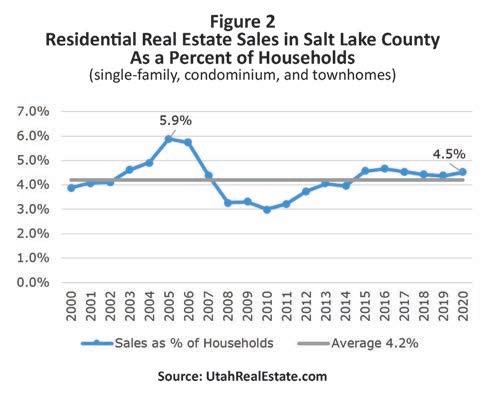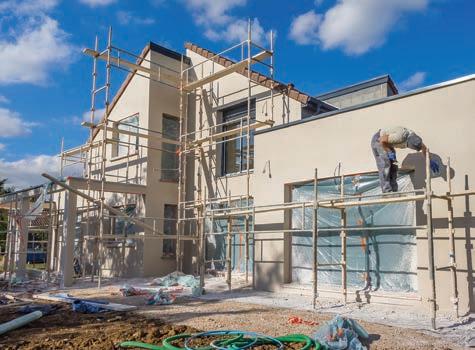
10 minute read
Housing Forecast Executive Report James Wood
An Exceptional Year for Salt Lake’s Housing Market | 2020 Was the Best Year in Overall Residential Sales
Salt Lake County Residential Real Estate Market: 2020 Review — 2021 Forecast
By James Wood
Ivory-BoyerSeniorFellow,KemC.GardnerPolicyInstitute,UniversityofUtah CommissionedbytheSaltLakeBoardofRealtors®
Extraordinary Growth in Jobs and Population
What’s behind the remarkable performance of Salt Lake County’s housing market? The short answer: the state’s extraordinary growth in jobs and population. Keep in mind that nearly half of all jobs in the state and 40% of the state’s population are located in Salt Lake County.
Since 2010, Utah has had the most rapidly growing job market in the country (Table 1). In just ten years, the number of non-farm jobs in Utah increased by nearly 30%, an increase of 290,000 jobs. Utah is almost an outlier in the rate of job growth. The state’s growth rate is far above other high-growth states such as Arizona, Florida, and Texas. In 2020, during the pandemic, Utah’s job market’s strength and resiliency have been on full display. The number of jobs in the state declined by just over one percent in 2020. Of all 50 states, only Idaho had a lower rate of decline. Nationally, the rate of decline is expected to be around six percent.
Table 1
States Ranked by Employment Change 2010-2020 (July to July*)
State % Change
1. Utah 29.4% 2. Idaho 25.2% 3. Arizona 19.0% 4. Florida 18.2% 5. Colorado 17.5% 6. Texas 16.7% 7. Nevada 14.6% 8. South Carolina 14.0% 9. Georgia 13.9% 10. Washington 13.9%
*Not seasonally adjusted
Source: U.S. Bureau of Labor Statistics
Utah also ranks first among all states in the rate of population growth from 2010 to 2019. The state’s population increased by 15.5% in nine years, an increase of 450,000 people (Table 2). Population and employment growth are key drivers of the demand for housing. The state’s rapid growth has had a widespread impact on Salt Lake County’s housing market, creating a housing shortage, pushing up home prices, and leading to a record level of sales for residential real estate.
Table 2 States Ranked by Population Growth 2010-2019
State % Change
1. Utah 15.5% 2. Texas 14.9% 3. Colorado 14.1% 4. Nevada 14.0% 5. Florida 14.0% 6. Idaho 13.8% 7. Arizona 13.6% 8. North Dakota 13.0% 9. Washington 12.9% 10. South Carolina 11.1%
Source: U.S. Census Bureau
Salt Lake County’s Housing Shortage
Generally, the demand for housing reflects changes in the number of households. The creation of new households through in-migration, marriage, kids going out on their own, etc., generates a need for additional housing units. New housing units are required to accommodate the increase in households. For decades the increase in housing units always slightly exceeded the growth in households. But since the Great Recession, the relationship has reversed, with the growth in households exceeding the increase in housing units. Currently, the deficit or shortage in Salt Lake County is around 5,500 units. While this on-going shortage is shrinking, due to recent high levels of residential construction, the shortage continues to impact the real estate market. The two most visible impacts are on sales and prices.
2020 — A Record Year for Sales?
Although the final sales numbers are not yet in, 2020 will likely be a record year for residential real estate sales in Salt Lake County. As of December 31st , total sales of 18,782 were only 26 short of the 2005 record of 18,808. While single-family sales of 13,500 are well short of a record year, condominium, townhome, and twin home sales could push total sales to a new record. The sales of condominiums, etc., will set a new high of around 5,300 units, capturing nearly 30% of all residential sales, the highest share of residential sales in the local housing market’s history.
A Second Measure of Sales
The historical data in Figure 1 do not consider the county’s demographic growth. As the population of the county increases, there should be a corresponding increase in home sales. Salt Lake County has many more households in 2020 than in the record year of 2005. In a boom year, real estate should be higher than sales 15 years ago. One way to account for the demographic increase is to compare real estate sales in a year to the number of households and calculate real estate sales as a percentage of total households. For example, the 18,782 sales in 2020 amount to 4.5% of the 416,848 households in Salt Lake County (Figure 2). A much lower percentage than the 5.9% in 2005 when households totaled only 319,620. The equivalent level of sales in 2020—equal to 5.9% of households— would require a 30% increase in sales to 24,600 homes. So, while sales in 2020 could be the highest ever numerically, adjusting for household growth shows that 2020 sales were just slightly higher than the long-term average of 4.2% (of sales as a percent

John©/ Adobe Stock
of total households). It should be noted that the housing market in 2005 was in an unsustainable boom, so the 5.9% share should not be viewed as a realistic target. What we can say is that the 4.5% share in 2020 is slightly above the long-term average but is likely suppressed by a shortage of listings. The best evidence of a suppressed number of sales due to a lack

of listings is the cumulative days on market data.


In 2020, the days on market reached an all-time low of 12 days for a single-family home, down from 24 days in 2019 and far below the long-term average of 41 days (Figure 3). Anecdotes abound about multiple offers, near auctions for listed homes, and sales prices well above listing prices. Indeed, signs of demand far exceeding supply.

Single-Family Home Prices
The rate of price increases moderated in 2018 and 2019, and it seemed like another year of moderation was in order for 2020. But conditions changed as the mortgage rate dropped from 3.45% in March to a historic low of 2.67% in December. The drop in rates was due to the Federal Reserve’s response to COVID-19. The Fed cut rates to avert a deep national recession. Lower interest produced a strong surge in demand for housing pushing up prices. In 2020 the median sales price of a, single-family home in Salt Lake County increased by 11.8% to $425,000.
Lake County Have Increased at an Average Annual Rate of 5.1%
Long-term demographic and economic growth has generated rapid increases in housing prices in Salt Lake County. The median sales price of a home in the county has increased from $129,000 in 1996 to $425,000 in 2020, an average annual growth rate of 5.1% (Figure 5). Over the same period, housing prices nationally have increased at a 3.7% annual rate. Most notable is the increase in prices in the past five years. From 2015 to 2020, the median sales price has increased from $272,900 to $425,000, an average annual increase of 9.3%; fifty percent higher than the national rate of growth of 6.2%. Housing prices in Salt Lake County have not only been among the most rapidly increasing in the country, but the median price is also among the highest. According to the National Association of Realtors® report, the median sales price in the third quarter of 2020 in the Salt Lake Metropolitan Area ranked 21st highest out of 181 metro areas. In other words, the median sales price

John©/ Adobe Stock
of a home in the Salt Lake Metro Area is higher than

Since 1996, Housing Prices in Salt
88% of all major metro areas.

Growing Concern for Housing Affordability
The increase in housing prices is excluding more families from homeownership. Despite the drop in the mortgage rate, the monthly payment for the median-priced home in Salt Lake County has increased from $1,743 in 2015 to $2,416 in 2020 (Figure 6). Both property taxes and private mortgage insurance are based on the price of the home. For the buyer of the median-priced home in 2020, the property taxes are nearly $100 higher than in 2015, and the monthly cost for private mortgage insurance is $127 higher. These increases pretty much wipe out the savings from lower interest rates. In 2015 it took an income of $70,000 to buy the median-priced home in Salt Lake County. Five years later, it takes an income of $97,000, an increase of 39% in five years. (continued on page 18)

A N N O U N CIN G Utah’s Signature Award-Winning Lifestyle and Real Estate Publication from the In-House Creative Team at Summit Sotheby’s International Realty
COLLECTIONS
THE HOMES, ESTATES AND LIFESTYLES OF UTAH | WINTER 2021
summitsothebysrealty.com

From print magazines to digital marketing and a global network like no other, our sales associates and clients here at Summit Sotheby’s International Realty all benefit from having a dedicated in-house advertising agency available at their fingertips. We offer million-dollar marketing for every listing regardless of area, size of home or price point.
COMPETING OFFERS?
BREATHE EASY

2021 Economic Forecast
The most recent economic forecast for the state (October 2020) shows a strong post-pandemic rebound. Key points from the 2021 statewide forecast:

Employment growth at 3.8% – Statewide employment growth is forecast for 3.8%, an increase of 58,000 jobs, which would be the largest single-year increase in jobs in Utah’s history. However, the 3.8% rate of growth has been exceeded in many years, but it would still be the highest growth rate since 2006.
Salt Lake County Demographic Growth Rate
Remains Unchanged – 2021 net in-migration holding steady at about 4,000 and a population increase of nearly 15,000. Salt Lake County Employment Recovers – County employment will increase by 25,000 jobs, nearly returning to the pre-pandemic level of 736,000. Tight Labor Market Returns – In April, the unemployment rate in Salt Lake County hit 11.2%, but by November it had dropped to 4.2%. With the statewide job recovery, the unemployment rate in the county will drop below 3.5%. Increase in Average Pay Remains Modest – The average wage in Salt Lake County is forecast to increase by 2.5% in 2021 to $60,500. Residential Construction Stable – Lower levels of apartment construction will offset gains by the single-family and condominium sectors as total number of new units remains stable at about 9,000.
Eleonore H©/ Adobe Stock John©/ Adobe Stock

Outlook for Mortgage Rates
Most experts agree that mortgage rates will remain around 3% in 2021. The average forecast from seven of the largest mortgage lenders and housing-related groups is 3.04% (Table 3).
Table 3 Forecast of 30-Year Fixed Mortgage Rate for 2021
Mortgage Bankers Association 3.3% National Association of Realtors 3.0% Realtor.com 3.4% Freddie mac 3.0% National Association of Home Builders 2.9% Fannie Mae 2.7% Wells Fargo 3.0% Average of Seven Forecasts 3.04%
Housing Forecast for 2021
Continued historically-low interest rates and a strong rebound from the pandemic suggest that 2021 could be another record-breaking year for the Salt Lake County real estate market. The total number of sales will reach 19,500, finally breaking the 19,000 barrier. Sales of single-family homes will be up nearly four percent to 14,000 units, and condominium/ townhome units will set another record with 5,500 in sales, an increase of six percent. Anecdotes from Realtors® and home builders indicate an increase in out-of-state buyers due to growing opportunities for remote work. The size of this new market segment is unknown, but it could support higher levels of sales and put upward pressure on prices in 2021. In contrast, high home prices will exclude some potential buyers from the market. Affordability issues will temper price increases in 2021. Another year of a double-digit increase is unlikely. Expect the median sales price of a single-family home to increase by 6%-8% to $455,000, and the price of condominiums/townhomes to increase by 9%-10% to $335,000. And finally, residential real estate commissions will increase from $490 million in 2020 to $550 million in 2021.

